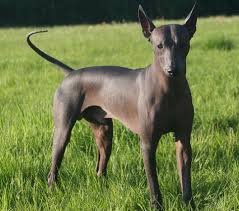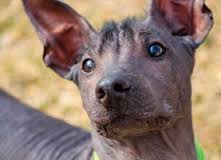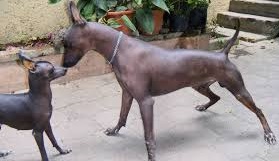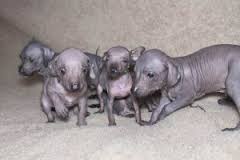The Xoloitzcuintli, or Xolo for short, is a hairless breed of dog, found in toy, miniature, and
standard sizes. The Xolo also comes in a coated variety and all three sizes can be born to a single litter.
It is also known as Mexican hairless dog in English-speaking countries, and is one of several breeds of
hairless dog.
In Nahuatl, from which its English name originates, its name is xoloitzcuintli (singular) and xoloitzcuintin
(plural). The name xoloitzcuintli comes from the god Xolotl and itzcuintli , meaning dog in Nahuatl.
A genetic study was recently conducted in order to determine the origin of the Xoloitzcuintli breed. The
study did not find a close genetic relationship between Xoloitzcuintli and the Chinese Crested Dog, another
hairless breed that is cited by the American Kennel Club as an ancestor to the Xoloitzcuintli. However,
the study showed that this breed did not result from a separate domestication of dogs in the New World.
Xoloitzcuintli appear to have been a result of a mixture of several Old World dog breeds.
Description

The breed ranges in size from about 10 to 50 lb (4 to 20 kg). Similar in appearance to a Pharaoh Hound, with
a sleek body, almond-shaped eyes, large bat-like ears, and a long neck, the Xolo is notable for its dominant
trait of hairlessness. The dominant hairless trait originated in this breed as a spontaneous mutation
thousands of years ago. The recessive expression of the trait will produce a coated variety, which is
genetically inseparable from the hairless, as the homozygous appearance of the hairless mutation is fatal to
the unborn pup. Most litters contain both hairless and coated puppies. The coated variety, covered with a
short, flat dense coat represents the original form of the dog, prior to the occurrence of the spontaneous
hairless mutation. The hairless variety is completely hairless on the body, with many dogs exhibiting a few
short hairs on the top of the head, the toes, and the tip of the tail. Most hairless dogs are black or
bluish-gray in color. The allele responsible for the Xolo's hairlessness also affects the dog's dentition:
Hairless Xolos typically have an incomplete set of teeth while the dogs of the coated variety have complete
dentition.
The Xolo is moderate in all aspects of its appearance, conveying an impression of strength, agility, and
elegance. Xolo body proportions are rectangular, slightly longer in total body length than the height
measured at the highest point of the withers (top of the shoulders). The breed occurs naturally in two
varieties, hairless and coated. Hairless Xolos are the dominant expression of the heterozygous Hh hairless
trait. Coated Xolos (hh) are the recessive expression, and breeding hairless to coated or hairless to
hairless may produce pups of either or both varieties. Breeding coated to coated will only produce coated
pups because they are recessive to the hairless trait and do not carry the dominant H gene.
Both varieties occur in all hair or skin colors, and often marked, splashed, or spotted. The most common
colors are various shades termed black, blue, and red. The breed occurs in a range of sizes, which breeders
have standardized into three designations.
Temperament
The Xoloitzcuintli's 'primitive' temperament (very high intelligence, sensitivity, high energy,
inquisitiveness, strong hunting, and social instincts) is apparent because the breed's temperament was not
modified overall by selective breeding in their native history in Mexico. This has also ensured a sturdy
physical nature and vigorous health generally innate in both coated and uncoated Xolos. Adult Xolos are
frequently noted for their calm demeanor, although puppies can be extremely energetic, noisy, and very oral
until they reach maturity (after 2 years old), after which they tend to settle down and become more calm.
Inadequately supervised or exercised Xolos can become escape artists, climbing and jumping fences to chase.
Many individuals of this breed can possess guard dog ability and will not back down from a fight. At the
same time, adult dogs, when they are raised properly, can become steady, well-behaved, and affectionate
companions.
Though physically grown at one year, many dog breeds including Xolos, are not 'emotionally mature' until
around two years. Like active breeds such as terriers, Xolos need calm, consistent, and loving obedience
training and regular socialization during their growing years. Well-raised Xolos bond strongly with their
owners, becoming highly devoted to their families while frequently choosing one specific family member as
favorite.
Anyone considering acquiring a Xolo should expect to spend time educating themselves in positive dog training
techniques, and, ideally, should have prior experience with active and intelligent dog breeds. A spacious,
well-fenced, and safe physical environment is desirable for this breed. Daily walks are ideal for exercising
most toy-sized Xolos, however more stimulating physical and mental exercise is advised for larger and more
active individuals. Behavior problems in Xolos are typically a result of a dog receiving inadequate or
inconsistent supervision, as well as inadequate exercise and mental stimulation. The Xoloitzcuintli is a
social dog that should not, in most cases, be an "only dog". It does not do well when kept as an outside-only
dog. This is a breed that is at its best when it is made part of the family, receiving regular interaction
and socialization with its humans (and other dogs, whether present in the home or as regular playmates).
Reproduction
In domestic dogs, sexual maturity begins to happen around age six to twelve months for both males and
females, although this can be delayed until up to two years old for some large breeds. This is the time at
which female dogs will have their first estrous cycle. They will experience subsequent estrous cycles
semiannually, during which the body prepares for pregnancy. At the peak of the cycle, females will come into
estrus, being mentally and physically receptive to copulation. Because the ova survive and are capable of
being fertilized for a week after ovulation, it is possible for a female to mate with more than one male.
2-5 days after conception fertilization occurs, 14-16 days later the embryo attaches to the uterus and after
22-23 days the heart beat is detectable.
Dogs bear their litters roughly 58 to 68 days after fertilization, with an average of 63 days, although the
length of gestation can vary. An average litter consists of about six puppies, though this number may vary
widely based on the breed of dog. In general, toy dogs produce from one to four puppies in each litter,
while much larger breeds may average as many as twelve.
Some dog breeds have acquired traits through selective breeding that interfere with reproduction. Male French
Bulldogs, for instance, are incapable of mounting the female. For many dogs of this breed, the female must
be artificially inseminated in order to reproduce.
Diet
Despite their descent from wolves and classification as Carnivora, dogs are variously described in scholarly
and other writings as carnivores or omnivores. Unlike obligate carnivores, dogs can adapt to a wide-ranging
diet, and are not dependent on meat-specific protein nor a very high level of protein in order to fulfill
their basic dietary requirements. Dogs will healthily digest a variety of foods, including vegetables and
grains, and can consume a large proportion of these in their diet, however all-meat diets are not recommended
for dogs due to their lack of calcium and iron. Comparing dogs and wolves, dogs have adaptations in genes
involved in starch digestion that contribute to an increased ability to thrive on a starch-rich diet.








